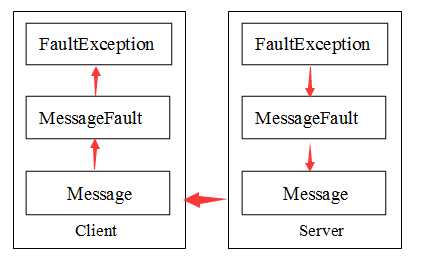WCF中的异常
一、考虑到安全因素,为了避免将服务端的异常发送给客户端。默认情况下,服务端出现异常会对异常屏蔽处理后,再发送到客户端。所以客户端捕捉到的异常都是同一个FaultException异常。

例如在服务端直接产生一个空引用异常,客户端捕获到的是上述异常。
服务端:
class Program
{
static void Main(string[] args)
{
ServiceHost host = new ServiceHost(typeof(SayHello));
host.AddServiceEndpoint(typeof(ISayHello), new WSHttpBinding(), "http://localhost:4216");
host.Opened += delegate { Console.WriteLine("Service Start!"); };
host.Open();
Console.ReadLine();
}
}
[ServiceContract]
public interface ISayHello
{
[OperationContract]
void Say();
}
public class SayHello : ISayHello
{
public void Say()
{
string name = null;
Console.Write("Hello {0}", name.Length);
}
}
客户端:
class Program
{
static void Main(string[] args)
{
ISayHello ClientChannel = ChannelFactory<ISayHello>.CreateChannel(new WSHttpBinding(), new EndpointAddress("http://localhost:4216"));
try
{
ClientChannel.Say();
}
catch (Exception ex)
{
Console.WriteLine(ex.Message);
Console.WriteLine(ex.StackTrace);
}
}
}
二、可通过配置ServiceDebugBehavior将IncludeExceptionDetailInFaults,将其置为true。则服务端会将异常原封不动的传递到客户端,该配置默认为false。
[ServiceBehavior(IncludeExceptionDetailInFaults=true)]
public class SayHello : ISayHello
{
public void Say()
{
string name = null;
Console.Write("Hello {0}", name.Length);
}
}
客户端捕捉到空引用异常。

三、自定义异常信息
1.直接通过FaultException构造函数,构造异常。
[ServiceBehavior(IncludeExceptionDetailInFaults=true)]
public class SayHello : ISayHello
{
public void Say()
{
throw new FaultException("自定义异常");
}
}
2.通过FaultException<TDetail>构造异常。
TDetail是一个可序列化的数据结构,如下面定义的myException。需要注意的是在操作契约上需要加一个错误契约, [FaultContract(typeof(myException))]。
[ServiceContract]
public interface ISayHello
{
[OperationContract]
[FaultContract(typeof(myException))]
void Say();
}
[ServiceBehavior(IncludeExceptionDetailInFaults=true)]
public class SayHello : ISayHello
{
public void Say()
{
myException ex = new myException
{
Message = "自定义异常",
OperatorMethodName = "SayHello:Say()"
};
throw new FaultException<myException>(ex, ex.Message);
}
}
[DataContract]
public class myException
{
[DataMember]
public string Message;
[DataMember]
public string OperatorMethodName;
}
客户端:
class Program
{
static void Main(string[] args)
{
ISayHello ClientChannel = ChannelFactory<ISayHello>.CreateChannel(new WSHttpBinding(), new EndpointAddress("http://localhost:4216"));
try
{
ClientChannel.Say();
}
catch (Exception ex)
{
myException myex = (ex as FaultException<myException>).Detail;
Console.WriteLine(myex.Message);
Console.WriteLine(myex.OperatorMethodName);
}
}
}

使用错误契约需要注意的地方:
(1)不能再同一个操作方法上声明相同的细节类型。如下所示:
[ServiceContract]
public interface ISayHello
{
[OperationContract]
[FaultContract(typeof(myException))]
[FaultContract(typeof(myException))]
void Say();
}
(2)错误契约上的细节类型不能等效。
[ServiceContract]
public interface ISayHello
{
[OperationContract]
[FaultContract(typeof(myException),Name="PersonalException",Namespace="www.cnblogs.cn/lh218")]
[FaultContract(typeof(myError), Name = "PersonalException", Namespace = "www.cnblogs.cn/lh218")]
void Say();
}
四、可以指定异常的序列化方式
默认的情况下异常消息还DataContractSerializer序列化的。可以通过XmlSerializerFormat的SupportFaults,指定使用XmlSerializer序列化异常消息。
[ServiceContract]
public interface ISayHello
{
[OperationContract]
[FaultContract(typeof(myException))]
[XmlSerializerFormat(SupportFaults=true)]
void Say();
}
五、错误消息的结构
由5部分组成
(1)FaultCode,可以看出是对异常消息的分类。结点内部的Value表示错误类型,SubCode表示错误子代码。
(2)FaultReason表示错误原因,内部有一个FaultReasonText集合,FaultReasonText支持全球化语言描述。
(3)FaultNode元素,表示在SOAP消息路由过程中产生异常的结点。
(4)FaultRole表示处理消息时所担当的角色。
(5)FaultDetail 即之前描述的错误细节。
下面代码讲创建一个错误消息:
using System.Xml;
using System.Xml.Serialization;
using System.ServiceModel;
using System.ServiceModel.Description;
using System.Runtime.Serialization;
using System.ServiceModel.Channels;
namespace ConsoleApplication4
{
class Program
{
static void Main(string[] args)
{
FaultCode subCode = new FaultCode("lh218", "www.cnblogs.com/lh218");
FaultCode code = new FaultCode("myFault", subCode);
var text1=new FaultReasonText("异常消息","zh-CN");
var text2=new FaultReasonText("Exception Message","en-US");
FaultReason reason=new FaultReason(new FaultReasonText[]{text1,text2});
myException exDetail = new myException
{
Message = "自定义异常细节",
OperatorMethodName = "myException"
};
MessageFault fault = MessageFault.CreateFault(code, reason, exDetail, new DataContractSerializer(typeof(myException)), "lhActor","lhNode");
Message msg = Message.CreateMessage(MessageVersion.Soap12WSAddressing10, fault, "http://myaction");
Write(msg, @"D://1.txt");
Console.ReadLine();
}
public static void Write(Message msg,string path)
{
using (XmlTextWriter writer = new XmlTextWriter(path,Encoding.UTF8))
{
writer.Formatting = Formatting.Indented;
msg.WriteMessage(writer);
}
}
}
}
消息为:
<s:Envelope xmlns:a="http://www.w3.org/2005/08/addressing" xmlns:s="http://www.w3.org/2003/05/soap-envelope">
<s:Header>
<a:Action s:mustUnderstand="1">http://myaction</a:Action>
</s:Header>
<s:Body>
<s:Fault>
<s:Code>
<s:Value>s:myFault</s:Value>
<s:Subcode>
<s:Value xmlns:a="www.cnblogs.com/lh218">a:lh218</s:Value>
</s:Subcode>
</s:Code>
<s:Reason>
<s:Text xml:lang="zh-CN">异常消息</s:Text>
<s:Text xml:lang="en-US">Exception Message</s:Text>
</s:Reason>
<s:Node>lhNode</s:Node>
<s:Role>lhActor</s:Role>
<s:Detail>
<PersonalException xmlns:i="http://www.w3.org/2001/XMLSchema-instance" xmlns="www.cnblogs.com/lh218">
<Message>自定义异常细节</Message>
<OperatorMethodName>myException</OperatorMethodName>
</PersonalException>
</s:Detail>
</s:Fault>
</s:Body>
</s:Envelope>
六、异常与消息之间的转换关系

如上图所示,MessageFault是FaultException和Message直接的中转对象。
先看Server端:
FaultException ==》MessageFault转换方法:FaultException对象可以调用CreateMessageFault创建MessageFault对象。
public virtual MessageFault CreateMessageFault();
MessageFault ==》 Message:Message调用CreateMessage创建,传入MessageFault参数。
public static Message CreateMessage(MessageVersion version, MessageFault fault, string action);
Client端:
Message==>MessageFault:MessageFault类型内部的CreateFault方法可以提取异常消息中的MessageFault
public static MessageFault CreateFault(Message message, int maxBufferSize);
MessageFault ==》FaultException:FaultException类型提供两个静态方法创建FaultException。
public static FaultException CreateFault(MessageFault messageFault, params Type[] faultDetailTypes);
public static FaultException CreateFault(MessageFault messageFault, string action, params Type[] faultDetailTypes);



